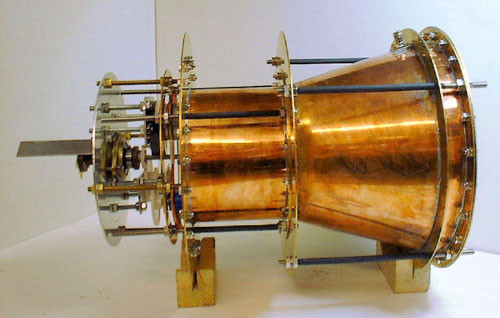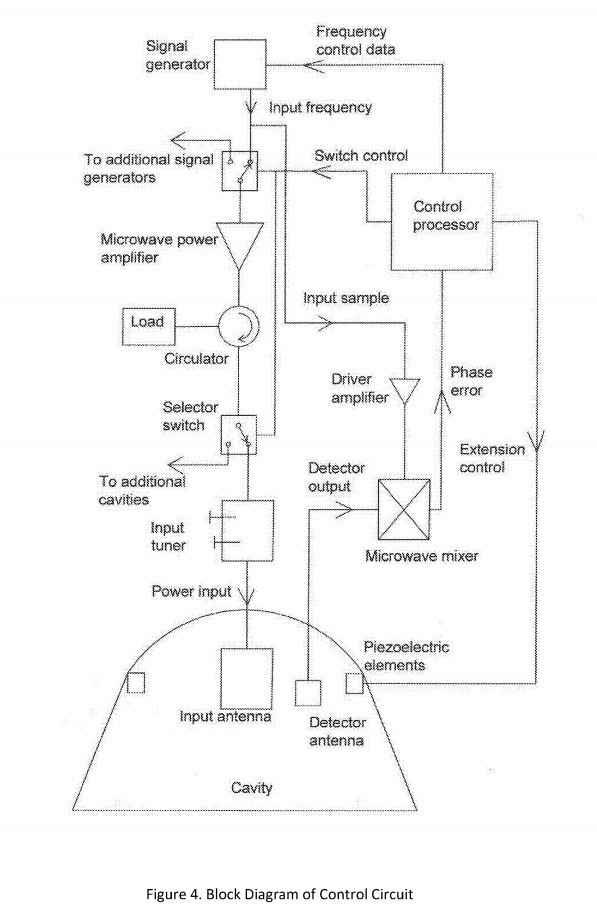EmDrive: Roger Shawyer is patenting a new design for next-gen superconducting thruster
The Intellectual Property Office has published Shawyer's application featuring novel superconducting end plates.
British EmDrive inventor Roger Shawyer has had his latest patent application for a next-generation superconducting thruster published by the UK Intellectual Property Office (IPO), showing that his development of the controversial space propulsion technology is going ahead.
The patent, available here, describes a thruster that features a single flat superconducting plate on one end, while the other end is a unique shaped plate that is non-superconducting.
In order to minimise the internal Doppler shift (the change in frequency or wavelength of a wave for an observer moving relative to its source), circular polarisation and a phase-locked loop control the microwave input to the thruster, which maximises thrust as it accelerates.
Shawyer told IBTimes UK that he submitted the patent for the next-generation microwave thrusters 18 months ago, and that the patent is significant as it is currently very difficult – not to mention expensive – to produce a shaped non-superconducting end plate, since it has to be mounted on a sapphire substrate.
"This is pretty significant because it enables you to easily manufacture these things, and we want to produce thousands of them," he said. "The patent makes the construction of a viable superconducting thruster easier, and it will produce a lot of thrust."
2016: A big year for EmDrive

How the EmDrive works
The EmDrive is the invention of British scientist Roger Shawyer, who proposed in 1999 that based on the theory of special relativity, electricity converted into microwaves and fired within a truncated cone-shaped closed metal cavity causes the microwave particles to exert more force on the flat surface at the large end of the cone (i.e. there is less combined particle momentum at the narrow end due to a reduction in group particle velocity), thereby generating thrust.
His critics say that according to the law of conservation of momentum, his theory cannot work as in order for a thruster to gain momentum in one direction, a propellant must be expelled in the opposite direction, and the EmDrive is a closed system.
However, Shawyer claims that following fundamental physics involving the theory of special relativity, the EmDrive does in fact preserve the law of conservation of momentum and energy.
Whether the technology actually works, there is no denying that 2016 has been a big year for the EmDrive. In mid-September, a respected space propulsion funding body in the US held a conference that included half a day dedicated to discussions about the EmDrive, led by a number of physicists, engineers and researchers.
Just before this, the American Institute of Aeronautics and Astronautics (AIAA) confirmed that it had peer-reviewed and accepted a paper on the EmDrive by Nasa Eagleworks researchers, which will be published in December 2016.
The researchers first posted on the Nasa Spaceflight forum in April 2015 and in November said they had succeeded in achieving thrust with the microwave thruster they built, although they didn't know how. In March, the researchers claimed that the paper was going through peer review, although they didn't know when it would be published.
There has been a great deal of debate over whether the EmDrive actually works. Many academics in the international space community continue to believe that it is complete nonsense, as the technology violates the law of conservation of momentum, and thus our understanding of physics.
In the meantime, Roger Shawyer, the British engineer/scientist who invented the EmDrive concept in 1999, is working with an unnamed UK aerospace company to develop the second generation of EmDrive, which will produce thrust many orders of magnitude greater than that observed by Eagleworks or any other laboratory.
Millions of pounds at stake on this patent

"The patent process is a very significant process, it's not like an academic peer review where everyone hides behind an anonymous review, it's all out in the open. This is a proper professional way of establishing prior ownership done by professionals in the patent office, and in order to publish my patent application, they had to first carry out a thorough examination of the physics in order to establish that the invention does not contravene the laws of physics," stressed Shawyer.
"There's millions of pounds at stake on this particular patent."
Shawyer has so far had four patents granted by the IPO – the first, GB2229865, was granted on 5 May 1993 and described the basic theory and construction of a cylindrical thruster with a shaped internal dielectric.
The second, GB2334761, granted on 21 March 2000, described the theory and construction of a tapered thruster with a cylindrical dielectric. This is essentially the same basic idea behind the NASA Eagleworks thruster that has been undergoing tests over the last two years.
The third patent, GB2399601, was granted on 13 March 2003, describing a second-generation EmDrive that uses no dielectric and employs superconducting technology to achieve high thrust.
Shawyer also has another patent still undergoing the patent review process – on 6 February 2013, the patent GB2493361 was published by the IPO, describing a thruster that uses shaped end plates and superconducting technology as a means of controlling the microwave input to maintain thrust under acceleration.
© Copyright IBTimes 2025. All rights reserved.





















